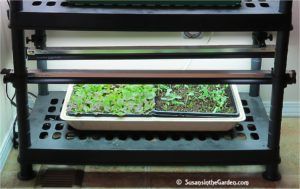Microgreens update

I’ve been growing microgreens for the first time this winter. It’s so much fun and a great way to eat healthy greens that I’ve grown myself indoors.
I wanted to give you an update to hear what I’ve learned since the last time I wrote about this.
But first, in case you’re sitting there saying, “microgreens? What in the world are those?,” I really should explain.
You know how some folks sprout seeds in water? Well, this is like sprouting seeds, only in potting mix rather than in water. I first became interested in trying them after interviewing a gentleman who’s been doing this for years.
With microgreens, you get more to eat because you let them grow a bit longer than you would with sprouts. (the only exception to this is with sunflower seeds because you want to harvest them before they develop their hairy, bitter true leaves)
Before I continue, please note that my original video on growing microgreens is at the bottom of this post.
This winter, I’ve grown sunflowers, beets, a Brassica mix, red Romaine lettuce and peas. All are absolutely delicious! I’d have to say the Brassica mix (“Long Life” mix from SproutPeople.org) is our favorite, though.
The trick to getting a great microgreens harvest is to plant the seeds really thickly… and I mean thickly! That took a bit of getting used to because I’ve trained myself over the years to sow seeds with proper spacing.
Here are the things I’ve learned about growing microgreens:
- As the seeds are germinating, don’t freak out if you see what you think is a bunch of white fuzzy mold on the surface of the potting mix. What you’re actually seeing are tiny root hairs, which are perfectly OK.
- You can use the cut-and-come-again method for harvesting lettuce, so you can get multiple pickings from a single sowing.
- The same applies to peas. I let them grow to about 4″ tall before harvesting them, and you’ll generally get another two pickings from that single sowing, although it won’t be as many as the first picking.
- Brassicas germinate in 2 days! And they grow beautifully when planted thickly. Even though the seedlings are small, they make up for it in quantity so I’m always pleased with the harvest. You only get a single harvest from them, though, but that’s OK. I’ve been able to harvest my Brassicas 10 days after sowing them.
- I’ve been reusing some of the potting soil for subsequent sowings for everything but the Brassica mix. That’s because, once you harvest the Brassicas, there’s a thick layer of roots and cut stems left over, which makes it hard to find a spot to sow more seeds. However, my husband Bill came up with an idea and it worked great! I actually flipped over the block of soil in that flat, roughed up the root area a bit and did my next sowing! I got just as good a germination using this method.
- When I can’t reuse the potting soil anymore, I add it to the compost pile.
As I’ve written about growing microgreens, I’ve been hearing some folks saying they want to give it it a try, too. I’m here to say, “GO FOR IT!” It’s easy and research has shown that microgreens have 4 to 6 times the nutrition of their mature counterparts, so they are super healthy.
Here’s the original video I shot about it, and how to grow microgreens:

